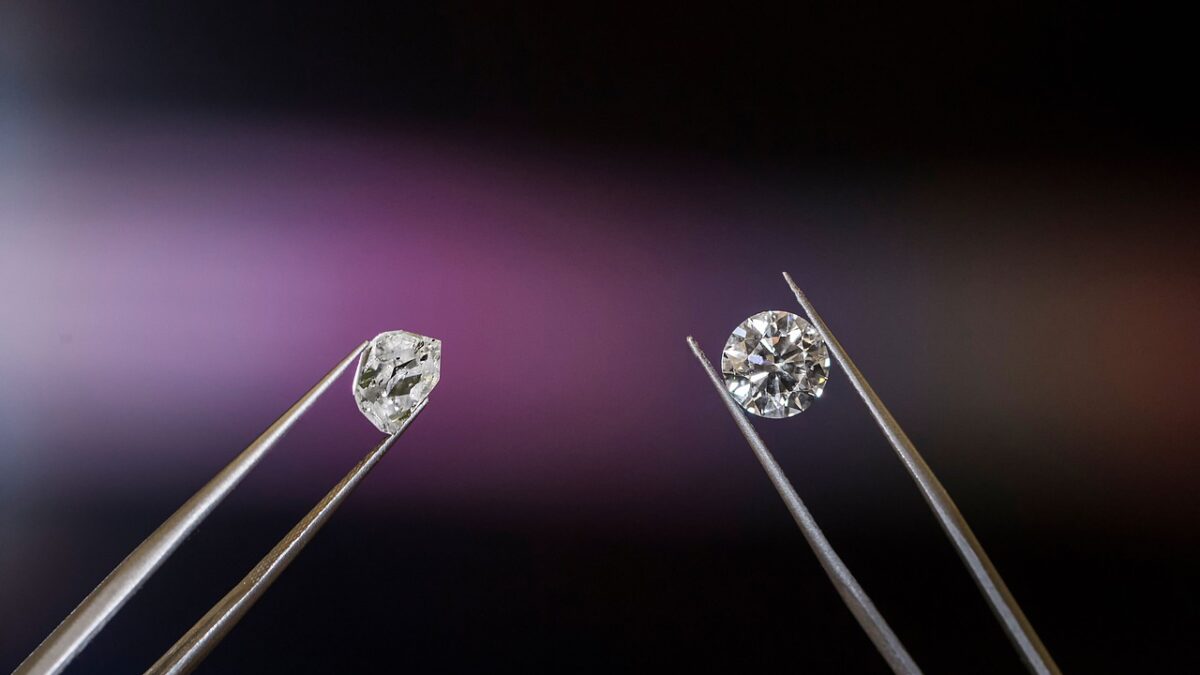The raw diamond trade is organized around major players in the mining sector. Such as De Beers, Alrosa, and Rio Tinto. Each company sells lots of diamonds via its own sales channels. By contract with diamond dealers or via auctions.
De Beers has set up a system of sales to wholesalers and manufacturers who are handpicked and who are called Sightholders.
Other mining companies like Alrosa or Rio Tinto have signed contracts with wholesalers. They sell them batches of diamonds every month.
Apart from these big players in the mining sector who have millions of carats in stock. Which alone represents 3/4 of the annual production volume. There are still the small operators to whom we can find a source of supply.
There are also stock exchanges that specialize in the trading of raw diamonds and polished diamonds. In Antwerp (Belgium), London (United Kingdom), Tel Aviv (Israel), Bombay (India), and New York (USA).
The Kimberley Process Certificate
The raw diamond trade is governed by the Kimberley Process Certificate.
Diamond-producing countries, importing and exporting countries. The diamond industry has developed a certification system for international trade. In raw diamonds to combat blood diamonds and conflict diamonds.
The role of the Kimberley Process certification scheme is to control exports. Imports of raw diamonds and sanctions countries that break the rules.
Raw diamond price
What is the price of raw diamonds? We are very often asked this question but it is impossible to answer. Because there are too many different categories and qualities of raw diamonds. It’s a bit like asking you the question: what is the price of a car?
To buy or sell a raw diamond, it is necessary to know the diamond very well as a whole, both the raw and the cut diamond. It is necessary to have solid knowledge in this field and very good experience. To be able to negotiate the prices at the right price.
Going into this business without knowing anything about it is pure madness. You will lose money, guaranteed. It is a trade of specialists.
It is obvious that if you contact De Beers to buy diamonds you will have in front of you a reliable interlocutor. But if you go to the African bush to buy, it will be a completely different matter, riskier.
It’s not like for the cut diamond where there is the Rapaport price to calculate the price of a diamond. For the raw diamond, there is no official price.
Raw diamond producers
The main diamond deposits are located in Africa, Russia, Canada, and to a lesser extent in South America.
Some Australian deposits are currently depleted.
Almost all the countries at the bottom of the African continent have diamond deposits: South Africa, Botswana, Namibia, Zimbabwe, Angola, Lesotho, Tanzania, the Democratic Republic of Congo, Central African Republic, etc.
Russia is one of the biggest producers of diamonds in the world, with more than 20 million carats per year.
There is only one mining company that operates the different mines in this country. It is the company Alrosa.
Canada is the second-largest producer of diamonds, various mines are in operation in the Canadian far north. Canada produces between 15 and 20 million carats per year.
The 3 largest diamond producers (De Beers, Alrosa, and Rio Tinto) alone account for more than 65% of world production in volume in 2020.
- De Beers: they operate diamond mines in Namibia, South Africa, Botswana, and Canada. They market raw diamonds via 2 channels: the “De Beers Group Sightholder Sales” and the “De Beers Group Auctions”.
- Alrosa: they operate mines only in Russia, it is the only player in the diamond mining sector in this country. It is one of the largest diamond producers in the world. They market their lots of diamonds through contracts with diamond dealers, auctions, and occasional sales.
- Rio Tinto: they operate the Diavik mine in Canada which produces +/- 6 million carats per year. They market the diamonds via long-term contracts with cutters and diamond dealers as well as via auctions.
Other mining companies operate diamond mines, we can mention:
- Arctic Canadian Diamond Company: they operate the Ekati mine in Canada. Which produces between 3 and 4 million carats per year.
- Petra Diamonds Limited: this company operates various mines in South Africa. It produces between 1.5 and 2 million carats per year.
- Lucara Diamond: they operate the Karowe mine in Botswana. That produces between 300,000 and 400,000 carats per year.
- Gem Diamonds: they operate the Letšeng mine in Lesotho and the Ghaghoo mine in Botswana. They produce +/- 100,000 carats per year.
Raw diamond sorting
Once the diamond has been recovered, it is necessary to sort it by category. We distinguish these categories:
- The diamond that is good for cleavage
- The diamond that is good for sawing
- The diamond that is good for cutting
- Diamond for industry
Only 20% of the production will be destined for jewelry, the remaining 80% will be destined for industry (diamond saws, cutting or drilling tools, etc.).
The crushing-bort or bort is the worst quality of raw diamonds. It will not be used for jewelry but it will be crushed and used as diamond powder.


